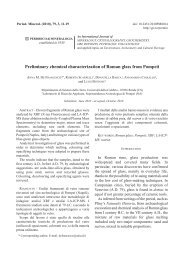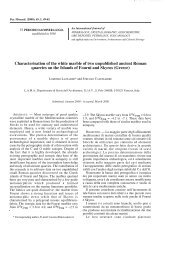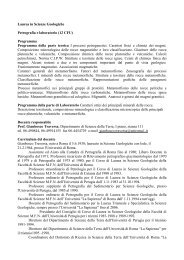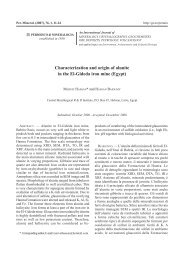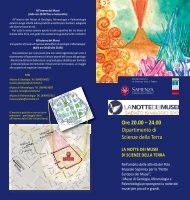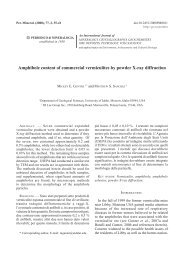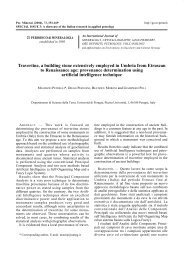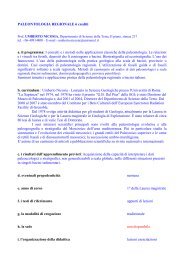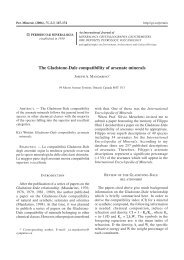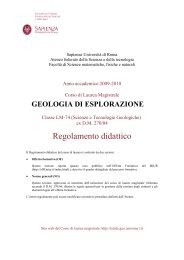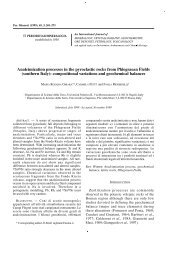Glass mosaic tesserae from Pompeii - Scienze della terra
Glass mosaic tesserae from Pompeii - Scienze della terra
Glass mosaic tesserae from Pompeii - Scienze della terra
Create successful ePaper yourself
Turn your PDF publications into a flip-book with our unique Google optimized e-Paper software.
Per. Mineral. (2006), 75, 2-3, 25-38 http://go.to/permin<br />
�<br />
PERIODICO di MINERALOGIA<br />
established in 1930<br />
Abstract. — This work reports the results of an<br />
archaeometrical investigation performed, through<br />
a multi-technique approach, on a series of Roman<br />
glass <strong>mosaic</strong> <strong>tesserae</strong> found in <strong>Pompeii</strong> excavations.<br />
Chemical and mineralogical analyses of <strong>mosaic</strong><br />
<strong>tesserae</strong> of different colours were performed in order<br />
to single out the colouring and opacifying agents<br />
employed during the Roman Imperial Age. Moreover,<br />
due to the paucity of information on the production<br />
technology of <strong>mosaic</strong> <strong>tesserae</strong>, the chemical data are<br />
compared with that of common transparent glass<br />
found at the same site, in order to evaluate whether<br />
vessels and <strong>mosaic</strong> <strong>tesserae</strong> could have been prepared<br />
with the same recipes and starting <strong>from</strong> the same<br />
glass batch. The chemical analyses were performed<br />
by electron microprobe, whereas the mineralogical<br />
investigation on the opaque samples were carried<br />
out by coupling scanning electron microscopy and<br />
X-ray powder diffraction. The results obtained<br />
show that all the samples analysed have the typical<br />
composition of natron-based glass. The similarities<br />
with the chemical composition – at least in terms of<br />
major elements – of common transparent glass could<br />
suggest the use of the same raw materials for the<br />
preparation of the batch. All opaque blue and green<br />
<strong>tesserae</strong> contain crystalline aggregates respectively<br />
of calcium and lead antimonates, except one blue<br />
tessera, which contains traces of cuprorivaite and<br />
quartz (Egyptian blue pigment). The red sample<br />
An International Journal of<br />
MINERALOGY, CRYSTALLOGRAPHY, GEOCHEMISTRY,<br />
ORE DEPOSITS, PETROLOGY, VOLCANOLOGY<br />
and applied topics on Environment, Archaeometry and Cultural Heritage<br />
<strong>Glass</strong> <strong>mosaic</strong> <strong>tesserae</strong> <strong>from</strong> <strong>Pompeii</strong>: an archeometrical investigation<br />
Rossella Arletti 1 , Simona Quartieri 2 , Giovanna Vezzalini 1*<br />
1 Dipartimento di <strong>Scienze</strong> <strong>della</strong> Terra, University of Modena and Reggio Emilia, L.go S. Eufemia 19, Modena I-41100<br />
2 Dipartimento di <strong>Scienze</strong> <strong>della</strong> Terra, University of Messina, Salita Sperone 31, Messina S. Agata I-98166<br />
* Corresponding author, E-mail: vezzalini.giovanna@<br />
unimore.it<br />
shows the presence of cuprite aggregates dispersed<br />
in a lead-rich matrix.<br />
This paper is dedicated to the memory of the friend<br />
and colleague Filippo Olmi, who prematurely passed<br />
away few months ago.<br />
Riassunto. — In questo lavoro vengono presentati<br />
i risultati di uno studio archeometrico condotto su<br />
tessere di <strong>mosaic</strong>o provenienti dagli scavi di Pompei.<br />
Su numerosi campioni di diverse colorazioni sono<br />
state condotte analisi chimiche e mineralogiche<br />
al fine di caratterizzare gli elementi cromofori e<br />
opacizzanti impiegati in epoca imperiale. A causa<br />
<strong>della</strong> scarsità di informazioni disponibili riguardo la<br />
metodologia di produzione delle tessere musive di<br />
questo periodo storico, i dati chimici di tali reperti<br />
sono stati confrontati con quelli relativi a vetri<br />
trasparenti di uso comune rinvenuti negli stessi scavi,<br />
allo scopo di valutare l’eventuale uso delle stesse<br />
ricette e/o dello stesso vetro grezzo per la produzione<br />
di <strong>mosaic</strong>i e di vasellame trasparente. I dati chimici<br />
sono stati ottenuti utilizzando la microsonda<br />
elettronica, mentre le fasi cristalline, presenti come<br />
opacizzanti, sono state caratterizzate con diffrazione<br />
X da polveri e osservazioni al microscopio elettronico<br />
a scansione. I risultati ottenuti mostrano che tutti i<br />
campioni analizzati hanno la composizione tipica<br />
del vetro romano al natron. Le strette somiglianze<br />
tra la composizione in elementi maggiori delle<br />
tessere e dei manufatti trasparenti vitrei provenienti<br />
dallo stesso sito, suggeriscono l’impiego delle stesse<br />
materie prime per la loro produzione. Tutte le tessere<br />
opache analizzate hanno mostrato la presenza di fasi
26 R. Arletti, S. Quartieri, G. Vezzalini<br />
cristalline, in particolare antimoniati di calcio nei<br />
campioni blu, antimoniati di piombo nei campioni<br />
verdi. Solo una tessera blu è risultata essere costituita<br />
da blu egizio (cuprorivaite + quarzo). Infine la tessera<br />
rossa mostra la presenza di aggregati dendritici di<br />
cuprite dispersi in una matrice al piombo.<br />
Key Words: <strong>Glass</strong>, <strong>Pompeii</strong>, opacifiers, colorants,<br />
EMPA, XRPD, SEM-EDS.<br />
Introduction<br />
Mosaics are often considered to be one of<br />
the most outstanding and elaborate form of<br />
wall decoration in antiquity. Yet, little is known<br />
about their manufacturing technique and where<br />
the raw materials came <strong>from</strong>. Archeometrical<br />
investigations, aimed at understanding the<br />
composition and production techniques of these<br />
materials, have been performed in recent years,<br />
however some issues are still unresolved (see<br />
e.g. Brun et al., 1991; Fiori and Vandini, 1996;<br />
Mass et al., 2002; Mirti et al., 2002; Shortland,<br />
2002a).<br />
In the Roman age, beginning in the first half of the<br />
first century B.C., <strong>mosaic</strong>s became an autonomous<br />
form of artistic expression. Stone <strong>mosaic</strong>s – in<br />
general built with coloured rock fragments – were<br />
at first used exclusively for the decoration of floors,<br />
meeting the need to create works of art that would<br />
persist over time. This form of artistic expression<br />
aimed at creating visual decorations that, contrary<br />
to paintings, could be walked on and could easily<br />
be washed. The first most outstanding examples of<br />
these <strong>mosaic</strong>s were situated in the dining rooms<br />
of the houses where simple <strong>terra</strong>cotta was not<br />
sufficiently decorative. Paintings adorned the walls,<br />
but the <strong>mosaic</strong> flooring was ideal <strong>from</strong> the point of<br />
view of both its beauty and its practical aspects. At<br />
Pompei <strong>mosaic</strong>s were widely used also to decorate<br />
the walls of fountains, swimming pools, columns<br />
and vaulted ceilings, particularly in the fountains<br />
set in the gardens. These wall <strong>mosaic</strong>, that become<br />
well diffused in the Imperial Age, were made with<br />
glass paste, shells, and enamels to accentuate their<br />
brilliance.<br />
The knowledge of Roman glass comes mainly<br />
<strong>from</strong> Plinius’s writings (Naturalis Historia<br />
XXXVI), <strong>from</strong> archaeological excavations and<br />
<strong>from</strong> chemical analysis of the finds. The most<br />
reliable hypothesis regarding the production and<br />
distribution of glass in the Roman Age is that most<br />
of the glass produced in the Western provinces<br />
of the Empire came <strong>from</strong> large primary furnace<br />
sites in Middle Eastern regions (e.g. Turner, 1956;<br />
Picon and Vichy, 2003; Nenna, 1998), where sand<br />
and flux were melted together to produce large<br />
glass chunks. Following the Plinius description,<br />
the melting process took place in several steps and<br />
in different ovens in order to obtain a workable<br />
melt, homogeneous and without bubbles. Then<br />
the raw chunks were exported to be worked in<br />
widely distributed secondary production sites<br />
in the West, where the ingots were re-melted,<br />
coloured (or decolorized) and shaped (Freestone,<br />
1994; Freestone et al., 2000; Vallotto and Verità,<br />
2000). It thus seems logical that the basic recipe<br />
for the production of opaque glass in Roman<br />
times, would have been the same employed for the<br />
manufacture of vessels, and that only colouring<br />
and opacifying agents were added to the batch<br />
during the re-melting and shaping. The colouring<br />
of glass was probably the main issue, since it<br />
represents a difficult process for a variety of<br />
reasons. The first was knowing which ingredients<br />
to add: some colours were easy to produce, others,<br />
particularly the opaque colours, were far more<br />
complex. For example, opaque yellow and green<br />
required much skill in preparing the intermediate<br />
compound, dark blue required the addition of<br />
cobalt, a relatively rare component; red opaque<br />
<strong>tesserae</strong> require careful control of the oxidation<br />
condition of the furnaces. The heat of the furnace,<br />
the base composition of the glass, the temperature<br />
reached in the furnace, and the duration of heating<br />
were additional factors affecting the colour of the<br />
finished product (Newton, 1980). Hence, after<br />
James (2006), it is unlikely that raw or recycled<br />
glass was imported for <strong>tesserae</strong> manufacture, since<br />
it would be much easier to use coloured glass, in<br />
cake or sheets.<br />
In this work several <strong>tesserae</strong> of different colours<br />
– coming <strong>from</strong> <strong>Pompeii</strong> excavations – were<br />
selected in order to obtain information about the<br />
production cycles and the raw materials employed.<br />
Unfortunately, the precise provenance of these<br />
finds is not clear, since they were stored in <strong>Pompeii</strong><br />
excavation deposits and precise data about the<br />
archaeological context were not available. However,<br />
their archaeometrical investigation represents a
<strong>Glass</strong> <strong>mosaic</strong> <strong>tesserae</strong> <strong>from</strong> <strong>Pompeii</strong>: an archeometrical investigation 27<br />
very useful mean to add important information to<br />
the poor knowledge of <strong>mosaic</strong> glass manufacture<br />
of Imperial Age. In fact, it is still unclear whether<br />
opaque glass (in particular <strong>mosaic</strong> <strong>tesserae</strong>) and<br />
common trasparent glass were produced at the<br />
same sites and with the same recipes through the<br />
centuries. The aim of this work is twofold: i) to<br />
characterize, <strong>from</strong> the chemical and mineralogical<br />
point of view, the colouring and opacifying agents<br />
used, ii) to compare the results obtained here with<br />
literature data referred to transparent Pompeian<br />
glass (Arletti et al., 2006a, Vallotto and Verità,<br />
2000) to find similarities or discrepancies, at least<br />
as regards the major elements, and to evaluate the<br />
hypothesis of a common origin for these two kinds<br />
of material.<br />
Analysed samples<br />
Eight <strong>mosaic</strong> <strong>tesserae</strong> (about 5 × 5 mm) of<br />
different colours, were analysed:<br />
• Blue and light blue samples (PM 003, PM<br />
005, PM 007, PM 002).<br />
Two of the three blue samples (PM 003 and PM<br />
005) are opaque with a very dark blue colour; their<br />
surface is quite smooth and numerous bubbles<br />
are present. Sample PM 007 has a different<br />
appearance and an irregular surface, it seems to be<br />
an aggregate of small spherules of different blue<br />
nuances, suggesting it is a fragment of a pigment<br />
rather than a <strong>mosaic</strong> tessera. Sample PM 002 has<br />
a very light turquoise tint, few bubbles are present<br />
but its surface is visibly streaked.<br />
• Green and yellow <strong>tesserae</strong> (PM 004, PM 006,<br />
PM 008).<br />
The dark green tessera (PM 004) is slightly<br />
transparent with a very uniform appearance; only<br />
few circular bubbles are present. By contrast<br />
yellow samples PM 006 and PM 008 - which<br />
differ only for a green nuance of the latter - have<br />
heterogeneous surfaces, with several bubbles and<br />
crystalline inclusions.<br />
• Red tessera (PM 012).<br />
In the sample set only one tessera is red and its<br />
appearance is only slightly vitreous. A strongly<br />
opaque light green rim on all the sides of the<br />
tessera is observed, probably the result of surface<br />
weathering.<br />
Experimental<br />
EPMA analysis<br />
Wavelength dispersive Electron Microprobe<br />
Analysis (EPMA) was used to determine the<br />
chemical composition of major and minor<br />
elements. Small glass fragments of almost 1 mm3 were removed <strong>from</strong> the glass artefacts and mounted<br />
in a epoxy resin. After preparation the samples<br />
were polished using a series of diamond pastes<br />
<strong>from</strong> 6 to 1μm. A carbon coating was applied to<br />
the polished sections to prevent charging under the<br />
electron beam. The analyses were carried out by<br />
an ARL - SEMQ electron microprobe equipped<br />
with four scanning wavelength spectrometers at<br />
the Department of Earth Science of Modena and<br />
Reggio Emilia University. The elements analysed<br />
were: Si, Ti, Al, Mn, Mg, Fe, Ca, K, Na, P, Co, Sb,<br />
Cu, Pb. A series of certified natural standards were<br />
employed. The analyses were performed operating<br />
at 15 kV, 20 nA, using counting times of 5,10,5<br />
sec. on background-peak-background respectively<br />
(Arletti, 2005). To prevent the known migration<br />
phenomenon of alkalis under the electron beam<br />
(Rinaldi, 1981), a 30 μm defocused beam was<br />
used. Several points were analysed on each sample<br />
and the mean value of all the measurements was<br />
calculated. The results were processed for matrix<br />
effects using the PHI(ρZ) absorption correction of<br />
the Probe program (Donovan and Rivers, 1990).<br />
The results for major and minor elements are<br />
reported in Table 1.<br />
Scanning Electron Microscopy<br />
Backscattered electron images (BSE) and<br />
energy-dispersive (EDS) spectra were collected on<br />
polished samples, using a Philips XL40 electron<br />
scanning microscope equipped with an energy<br />
dispersive spectrometer OXFORD - SATW at the<br />
Centro Interdipartimentale Grandi Strumenti of<br />
the University of Modena and Reggio Emilia. The<br />
analyses were performed using an acceleration<br />
voltage of 25 kV and a working distance of 12<br />
mm. BSE images were mainly collected on opaque<br />
glasses to highlight the presence of crystalline<br />
opacifying agents in the glass matrix, and EDS<br />
analyses were run to obtain qualitative chemical<br />
analysis of the inclusions.
28 R. Arletti, S. Quartieri, G. Vezzalini<br />
Table 1 – Electron microprobe analyses (wt% in oxides)*.<br />
Samples PM 002 PM 003 PM 004 PM 005 PM 006 PM 007a PM 007b PM 008 PM 012<br />
Light-blue Dark-blue Dark-green Dark-blue Yellow Blue Blue Yellow-green Red<br />
SiO2 65.56 67.95 63.58 63.63 65.19 62.73 98.65 63.65 46.35<br />
Al2O3 2.39 2.48 2.57 2.70 2.48 0.25 0.01 2.81 1.57<br />
TiO2 0.09 0.09 0.11 0.07 0.08 0.02 0.04 0.17 0.26<br />
MnO 0.43 0.50 0.63 0.66 0.41 0.00 0.02 0.45 0.01<br />
MgO 0.67 0.56 0.98 0.59 0.58 0.09 0.01 1.01 0.47<br />
FeO 0.52 0.91 0.84 0.87 0.70 0.09 0.00 0.92 0.64<br />
CaO 7.52 7.25 6.72 7.81 6.79 14.30 0.02 6.51 3.03<br />
Na2O 16.57 17.29 16.43 17.83 16.33 0.45 0.08 18.23 14.33<br />
K2O 0.66 0.60 0.90 0.61 0.63 0.09 0.00 0.79 0.22<br />
P2O5 0.24 0.08 0.26 0.11 0.12 0.00 0.00 0.28 0.02<br />
Sb2O5 3.20 1.48 0.14 3.59 0.44 0.00 0.00 0.21 1.45<br />
Cu2O 0.43 0.23 3.46 0.11 0.41 19.27 0.21 0.97 8.40<br />
PbO 0.77 0.04 2.24 0.02 4.55 0.00 0.00 3.08 23.88<br />
CoO 0.01 0.12 0.00 0.10 0.01 0.01 0.02 0.00 0.39<br />
Totals 99.04 99.58 98.85 98.71 98.72 97.29 99.07 99.08 101.03<br />
* average of 8 analyses on different spots.<br />
X-Ray Powder Diffraction<br />
X-ray powder diffraction spectra were collected<br />
<strong>from</strong> all the samples, with the aim of identifying<br />
the crystalline phases dispersed in the glass matrix.<br />
The analyses were carried out on few mgs of glass<br />
powder using a Philips PW1729 diffractometer<br />
with Bragg-Brentano geometry θ - 2θ and CuKα<br />
radiation using a zero background quartz holder.<br />
The spectra were collected <strong>from</strong> 5 to 80° 2θ by<br />
using a 0.02° θ step and counting time of 4 sec for<br />
each step.<br />
Results<br />
Chemical analyses<br />
From the chemical results of the major elements<br />
in the <strong>mosaic</strong> <strong>tesserae</strong> (Table 1) it is clear that sample<br />
PM 007 is not a glassy tessera, but a heterogeneous<br />
mixture of at least two different phases – reported<br />
in two different columns of Table 1: a) a phase rich<br />
in Cu, Ca and Si, and b) quartz.<br />
The chemical data of the other <strong>tesserae</strong> show<br />
that almost all the samples have the characteristic<br />
composition of silica-soda-lime Roman glass<br />
typical of the Imperial Age, showing high levels<br />
of SiO 2 (ranging <strong>from</strong> 62.73 to 67.95%), Na 2 O<br />
(16.33 - 17.83%) and CaO (6.72 - 7.81%) (e.g.<br />
Turner, 1956; Sayre and Smith, 1961; Henderson,<br />
1985; Verità, 1995). The Al 2 O 3 content is quite low<br />
and constant over the whole sample set, probably<br />
reflecting the constant presence of feldspar in<br />
the sands used for production (Freestone, 1994).<br />
In fact, the levels of CaO and Al 2O 3 of these<br />
<strong>tesserae</strong> roughly match the ratio found in typical<br />
Roman glass, suggesting the use of calcareous<br />
sands containing feldspar as impurities. The only<br />
exception is sample PM 012, with lower levels of<br />
these elements as a consequence of high levels of<br />
lead (PbO exceeding 20 %) present in this tessera.<br />
The low concentrations of K 2 O, MgO and P 2 O 5<br />
suggest that almost all samples were produced<br />
using natron as flux. Natron is a natural sodium<br />
sesquicarbonate (Na 2CO 3∙NaHCO 3∙2H 2O) that,<br />
especially during Roman Age, was mined in Egypt
<strong>Glass</strong> <strong>mosaic</strong> <strong>tesserae</strong> <strong>from</strong> <strong>Pompeii</strong>: an archeometrical investigation 29<br />
(Wadi Natrun, North-West of Cairo) and used in<br />
glass-making activities throughout the Empire. The<br />
glass produced using this mineral source of alkalis<br />
is well discriminated <strong>from</strong> that produced using flux<br />
<strong>from</strong> organic sources (i.e. plant ash), which, along<br />
with Na 2O, generally presents higher levels of K 2O<br />
and MgO (Lilyquist and Brill, 1995).<br />
The amount of TiO 2 , FeO and MnO are very low,<br />
never exceeding 1%, and hence these elements<br />
were probably present as impurities in the sands.<br />
In general, intentional addition of iron, to confer<br />
a green nuance to the glass, or of manganese, as<br />
decolouring agent, is shown by higher percentages<br />
of these oxides in the glass composition<br />
(Henderson, 1985).<br />
The elements responsible of the colour and the<br />
opacity of these <strong>tesserae</strong> are Sb, Pb, Cu and Co.<br />
These elements are present in a wide range of<br />
concentrations (Table 1), in relation to the colour<br />
gradation and opaque effects of the <strong>tesserae</strong>.<br />
These issues will be dealt with in detail in the next<br />
sections.<br />
The chemical results reported here were<br />
compared with literature data for transparent glass<br />
found at <strong>Pompeii</strong> excavations (Arletti et al., 2006a,<br />
Vallotto and Verità, 2000) to evaluate a possible<br />
common origin for opaque and transparent glass<br />
coming <strong>from</strong> the same site. In Figures 1 and 2 the<br />
levels of CaO vs Al 2 O 3 , and of K 2 O vs MgO for<br />
the samples analysed in this work are compared<br />
with literature data for Roman glass <strong>from</strong> <strong>Pompeii</strong>.<br />
In Figure 1, where the compositional field of<br />
European Roman glass is drawn with dashes,<br />
almost all the samples (transparent and opaque)<br />
fall inside this area. Only PM 012 tessera shows<br />
lower levels of CaO and Al 2 O 3 , as a consequence<br />
of its high content of lead (which induces a<br />
dilution in the other oxides). The chemical data for<br />
transparent samples <strong>from</strong> literature have a spreader<br />
distribution, however the compositional field of<br />
the 2 sample sets are almost overlaid. In Figure 2<br />
the compositional range of natron-based glass and<br />
plant ash-based glass are delimited. All the samples<br />
studied in this work fall inside the first field and for<br />
only two Pompeian transparent samples the levels<br />
of MgO are slightly higher.<br />
Figures 3 and 4 report the data for TiO 2 , MnO<br />
and FeO contents. The levels of the minor elements<br />
MnO and TiO 2 , non intentionally added to the<br />
glass, are comparable for transparent common<br />
glass and <strong>mosaic</strong> <strong>tesserae</strong>. Only the sample PM<br />
012 has a different composition, since it does not<br />
Fig. 1 – CaO vs Al 2 O 3 for analysed samples and for the finds reported by Arletti et al. (2006a) and Vallotto and Verità (2000).<br />
The compositional field of European Roman glass is drawn with dashes.
30 R. Arletti, S. Quartieri, G. Vezzalini<br />
Fig. 2 – K 2 O vs MgO for analysed samples and for the finds reported by Arletti et al. (2006a) and Vallotto and Verità (2000).<br />
Rectangles represent compositional classes for natron and Na-plant ash based glass (Lilyquist and Brill, 1995). Symbols are<br />
the same of Figure 1.<br />
Fig. 3 – MnO vs TiO 2 for the analysed samples and for the finds reported by Arletti et al. (2006a) and Vallotto and Verità<br />
(2000). Symbols are the same of Figure 1.
<strong>Glass</strong> <strong>mosaic</strong> <strong>tesserae</strong> <strong>from</strong> <strong>Pompeii</strong>: an archeometrical investigation 31<br />
Fig. 4 – FeO vs MnO for the analysed samples and for the finds reported by Arletti et al. (2006a) and Vallotto and Verità<br />
(2000). Symbols are the same of Figure 1.<br />
contain manganese at all, but it is rich in titanium.<br />
This, along with the high level of lead and copper,<br />
makes this sample an exception <strong>from</strong> a chemical<br />
point of view. The situation is slightly different<br />
when FeO content is taken into account; in fact<br />
the plot of Figure 4, shows that, on average, the<br />
<strong>mosaic</strong> <strong>tesserae</strong> have higher iron contents than<br />
the transparent samples. Only four samples taken<br />
<strong>from</strong> literature have higher contents, but it is worth<br />
noting that these are deeply coloured transparent<br />
glass. It is hence reasonable to conclude that the<br />
higher levels of iron in coloured samples (though<br />
never exceeding 1%) could be the consequence<br />
of successive addition to the batch of colouring<br />
compounds, containing iron as impurity.<br />
Colouring and opacifying elements<br />
As reported in the previous paragraph, one of<br />
the blue samples (PM 007) is not a homogeneous<br />
vitreous material but it is composed by two<br />
phases: quartz and a phase rich in Si, Ca, and<br />
Cu. XRD analysis of this last phase corresponds<br />
to cuprorivaite CaCuSi O . In addition to the<br />
4 10<br />
crystalline phases, the spectral background<br />
suggests the presence of an amorphous one (Noll<br />
et al., 1975). BSE image (Figure 5) confirmed the<br />
presence of two different phases. Cuprorivaite, also<br />
known as Egyptian Blue, was the first synthetic<br />
pigment even produced. It appeared for the first<br />
time in Egypt in the 3 rd millennium B.C. (Fouqué,<br />
1889; Ullrich, 1987); later Vitruvius (VII, 11)<br />
reports that its formula was brought <strong>from</strong> Egypt<br />
to Pozzuoli, hence Egyptian blue became very<br />
common in <strong>Pompeii</strong> and Herculeneum (Chase,<br />
1971). This pigment has been widely analysed<br />
and characterized in recent years (Pabs, 1959;<br />
Mirti et al., 1995; Bianchetti et al., 2000). It was<br />
prepared by melting silica, calcium carbonate, and<br />
sodium flux at about 900°C, while, as Cu source,<br />
either malachite or scrap metals were used. Small<br />
amounts of tin could prove the use of scrap metals<br />
(Damiani et al., 2003); in this study, however, tin<br />
analysis was not performed, so it is impossible to<br />
define the copper source used. Cuprorivaite also<br />
occurs in nature near Naples (Mount Vesuvius<br />
area) but it is in general a very rare mineral phase<br />
(Minguzzi, 1938).<br />
Samples PM 003 and PM 005 show a very<br />
dark blue colour, consistent with the presence of
32 R. Arletti, S. Quartieri, G. Vezzalini<br />
Fig. 5 – BSE image of sample PM 007 showing the presence of quartz (dark grey) and of a silicatic phase rich in Ca and Cu<br />
(light grey). The labels indicate the points where the EDS analyses were performed.<br />
relatively high amounts of cobalt (CoO around<br />
0.10%, see Table 1). The SEM-EDS analyses<br />
performed on these <strong>tesserae</strong> show the presence<br />
of crystals of 1-2 μm containing calcium and<br />
antimony (Figure 6). Sample PM 002 has a lighter<br />
colour when compared with the previous ones,<br />
consistent with the chemical analysis that indicates<br />
a non detectable Co level. The light blue colour is<br />
probably due to the presence of low amounts of<br />
copper (see Table 1). Among the blue samples, PM<br />
002 has the highest antimony oxide content (3.2%),<br />
in agreement with the backscattered image (Figure<br />
7), which shows the presence of an high amount of<br />
calcium antimonate crystals of few microns across.<br />
Although the presence of dispersed opacifying<br />
particles was verified by BSE image for all the<br />
blue <strong>tesserae</strong> (even if in different amounts) none of<br />
XRPD spectra presented diffraction peaks.<br />
Two green <strong>tesserae</strong> were analysed, a transparent<br />
dark green (PM 004) and an opaque yellow-green<br />
(PM 008). As expected, no particles were identified<br />
in the first sample by SEM observations. The BSE<br />
image (Figure 8) shows a stripy surface, with two<br />
different grey tonalities. However, the qualitative<br />
chemical analysis of the two portions does not<br />
show significant compositional differences. The<br />
intense green colour of tessera PM 004 is probably<br />
mainly due to copper, which is present in a very<br />
high percentage (Cu 2 O = 3.46%, Table 1).<br />
SEM-EDS investigation carried out on the<br />
yellow–green sample (PM 008) revealed large<br />
particle aggregates, containing lead and antimony,<br />
dispersed in a lead-rich matrix (Figure 9). The same<br />
aggregates were also found in the yellow tessera<br />
(PM 006), in agreement with the EPMA results.<br />
XRPD analyses performed on these two samples<br />
allowed to identify the presence of Pb 2 Sb 2 O 7 . The<br />
red tessera PM 012 has a green rim probably due<br />
to marked weathering. XRPD pattern of the whole<br />
tessera indicated the presence of malachite and<br />
cuprite in the rim and bulk, respectively. Large<br />
dendritic crystals of cuprite are responsible for the<br />
red opaque effect of the inner part of this tessera as<br />
demonstrated by SEM analysis (Figure 10).<br />
Discussion and Conclusions<br />
The parameters that affect the colour and the<br />
opacity of glass are complex. The most common
<strong>Glass</strong> <strong>mosaic</strong> <strong>tesserae</strong> <strong>from</strong> <strong>Pompeii</strong>: an archeometrical investigation 33<br />
Fig. 6 – BSE image of sample PM 003. The label indicates the point where the EDS analysis was performed.<br />
Fig. 7 – BSE image of sample PM 002.
34 R. Arletti, S. Quartieri, G. Vezzalini<br />
Fig. 8 – BSE image of sample PM 004.<br />
Fig. 9 – BSE image of yellow sample PM 008. The labels indicate the points where the EDS analyses were performed.
<strong>Glass</strong> <strong>mosaic</strong> <strong>tesserae</strong> <strong>from</strong> <strong>Pompeii</strong>: an archeometrical investigation 35<br />
Fig. 10 – BSE image of sample PM 012 showing the presence of dendrites of cuprite.<br />
colorants used in the production of coloured glass<br />
are transition metals; the colour of glass depends<br />
on the characteristic frequencies of the visible<br />
light absorbed by the colorant in the glass as the<br />
result of a d-d electronic transition. The opaque<br />
effect in glass is obtained by the scattering of<br />
crystals of appropriate size (less than the incident<br />
light wavelength) dispersed in the glass matrix.<br />
The scattering of crystals dispersed in a glassy<br />
matrix has been studied in detail by Mie (1908),<br />
demonstrating that the intensity of the opacifying<br />
effect depends on the number and dimension of<br />
the particles, and on the difference between the<br />
refraction index of the opacifier and that of the<br />
matrix.<br />
The opaque effect of the blue vitreous samples<br />
studied is certainly due to the presence of calcium<br />
antimoniate crystals, although XRPD experiments<br />
did not reveal the presence of the corresponding<br />
peaks, due to the strong background of the glass<br />
matrix. Our results are in agreement with several<br />
studies on white, turquoise, and some deep blue<br />
opaque glass, which revealed that the opacity is<br />
caused by small particles of calcium antimonate<br />
(Ca 2 Sb 2 O 7 or CaSb 2 O 6 ) within the matrix (Calvi<br />
et al., 1963; Mirti et al., 2002; Shortland, 2002a,<br />
Arletti et al., 2006a). These particles are mostly<br />
small and well dispersed in the glass and are new<br />
formed phases obtained by adding an antimony<br />
source, probably roasted stibnite, to a Ca-bearing<br />
batch. The deep blue colour is induced by the<br />
presence of very low amounts of cobalt, the most<br />
powerful blue colorant used in ancient times.<br />
Thanks to its linear absorption coefficient, the<br />
colouring power is five time greater than that of<br />
other transition metals: to produce a deep blue<br />
colour only a few hundred ppm are needed. All the<br />
blue samples have rather high amounts of copper<br />
associated to cobalt, suggesting that these two<br />
elements were associated in the Co-bearing raw<br />
materials. Cobalt, in fact, is often present in rock<br />
mineralisations associated to copper, like in trianite<br />
(2Co 2 O∙CuO∙6H 2 O) or to arsenic in the sulfide<br />
cobaltite (CoAsS) or to other transition metals, like<br />
iron, nickel, and arsenic (Co, Fe, Ni)As 3 . Gratuze<br />
and co-workers (1992) analysed several blue glass<br />
coming <strong>from</strong> France, <strong>from</strong> the Bronze age to<br />
the 18 th century and found three main groups of<br />
samples on the basis of the elements associated to<br />
cobalt. One set containing Co associated to Zn-In-
36 R. Arletti, S. Quartieri, G. Vezzalini<br />
Pb, one set containing sample high in Co, Ni and<br />
As and one including glass containing high cobalt<br />
amount, sometimes related to high nickel contents,<br />
sometimes not related to any particular element.<br />
However, these elements were not determined in<br />
this study, so it is impossible to classify the finds in<br />
one of the three compositional groups.<br />
The yellow nuance and the opaque effect in<br />
samples PM 006 and PM 008 (yellow and yellowgreen<br />
<strong>tesserae</strong>) are due to Pb 2 Sb 2 O 7 particles (Caley,<br />
1962; Lilyquist and Brill, 1995; Shortland, 2002a).<br />
If we consider the PbO/Sb 2 O 5 ratio in a yellow<br />
opaque glass, we notice that, in general, it is much<br />
higher than that required by the stochiometry of the<br />
lead antimonate. This means that lead antimonate<br />
was added to the glass along with other additional<br />
lead compounds. The origin of this lead antimonate<br />
in the glass is still uncertain and several hypotheses<br />
have been proposed concerning the production of<br />
yellow opaque glass. The most likely is that the<br />
minerals used are galena (PbS), as a source for<br />
lead, and stibnite (Sb 2S 3) for antimony. The ragged<br />
edges of the crystals suggest that they were added<br />
to the glass as lead antimonate in the presence of a<br />
lead excess, rather than as two different compounds<br />
(Shortland, 2002 a,b). The resulting green colour<br />
of sample PM 008 is produced by the co-presence<br />
of copper (which in its oxidised form confers a<br />
green colour) and of yellow lead antimonate.<br />
In recent years, several studies on red opaque<br />
glass have been performed to single out the<br />
agents responsible of both colour and opacity.<br />
Following Weyl (1951), the colour in red glass is<br />
produced by crystals of metallic copper dispersed<br />
in the glass matrix, the differences in the resulting<br />
nuances being mainly related to the dimensions<br />
of the particles. Mirti et al. (2002), studying glass<br />
fragments of the 7 th -8 th century <strong>from</strong> Cripta Balbi in<br />
Rome, found some red opaque samples containing<br />
small spherules of metallic copper, smaller than<br />
1μm across, dispersed in a homogeneous matrix.<br />
Padovani and co-workers (2003, 2004) in a study<br />
of red lustre decorations of Italian Renaissance<br />
pottery, found that the majority of copper was<br />
present as monovalent species, along with a minor<br />
level of metallic nano-particles. They concluded<br />
that the chromatic effect was determined only by<br />
the fraction of metal ions reduced to nano-particles.<br />
Also an EXAFS study performed on opaque red<br />
glass of the Roman Age <strong>from</strong> Italy (Arletti et<br />
al., 2006b) demonstrates that copper is present<br />
as monovalent cations coordinated to the oxygen<br />
atoms of the glass framework, accompanied by<br />
metallic clusters. A study on Celtic opaque red<br />
glass containing lead (Brun et al., 1991), revealed<br />
the presence of a large number of dendritic<br />
crystals of cuprous oxide (Cu 2 O), together with<br />
a few metallic copper nodules. Thus, red opaque<br />
glass can contain metallic copper clusters along<br />
with cuprous oxide particles, and copper cations<br />
dispersed in the glass matrix.<br />
In the red tessera studied in this paper (PM<br />
012), a large number of dendritic crystal of cuprite<br />
were found dispersed in the lead-rich matrix in<br />
agreement with the results of Brun et al., (1991).<br />
The glass composition and the melting conditions<br />
are the parameters that control the copper oxidation<br />
state. The presence of lead in the glass batch<br />
greatly facilitates the achievement of reducing<br />
conditions (Ahmed and Ashour, 1981), since this<br />
element displaces the redox equilibrium of copper<br />
to the cuprous state (Cu 2+ → Cu + ) whereas to<br />
obtain metallic copper (Cu 0 ) a stronger reducing<br />
condition – obtained usually with the addition of<br />
Fe – is needed. The presence of cuprite as opacifier,<br />
and the related high level of lead, is very unusual<br />
in Roman times, when for red <strong>tesserae</strong> the opaque<br />
effect was generally achieved by means of metallic<br />
copper particles (Arletti et al., 2006b). This could<br />
suggest that the sample PM 012 is either a failed<br />
production of glass with metallic Cu or a tessera<br />
of successive restoration, even though no literature<br />
data on <strong>Pompeii</strong> <strong>mosaic</strong> restorations is known. As<br />
seen in the previous section, a strong weathered<br />
malachite rim is present on our red tessera. None<br />
of the metallic Cu-bearing opaque red glass<br />
previously analysed and reported in literature show<br />
a similar weathering rim. Probably, the presence<br />
of cuprite crystals favours glass weathering, since<br />
monovalent copper is less stable and more alterable<br />
and subject to oxidation processes than metallic<br />
particles.<br />
Acknowledgements<br />
We are indebted to Dr. Annamaria Ciarallo of the<br />
Laboratorio Ricerche Applicate of the Soprintendenza<br />
Archeologica of Pompei for providing glass samples.<br />
The Centro Interdipartimentale Grandi Strumenti<br />
(C.I.G.S.) of the University of Modena and Reggio<br />
Emilia is acknowledged for the use of SEM instrument.
<strong>Glass</strong> <strong>mosaic</strong> <strong>tesserae</strong> <strong>from</strong> <strong>Pompeii</strong>: an archeometrical investigation 37<br />
Financial support was provided by Italian MIUR<br />
COFIN 2004 “Scienza dei materiali antichi derivati<br />
da geomateriali: trasferire le conoscenze di base delle<br />
geoscienze allo studio di vetri e metalli”. Isabella<br />
Memmi and Mariangela Vandini are acknowledged<br />
for the constructive comments which improved the<br />
paper.<br />
References<br />
Ahmed A.A. and Ashour G.M. (1981) – Effect of<br />
heat treatment on the crystallisation of cuprous<br />
oxide in glass. <strong>Glass</strong> Tech., 22, 24-34.<br />
Arletti R. (2005) – The ancient Roman glass:<br />
an Archaeometrical investigation. PhD thesis,<br />
University of Modena and Reggio Emilia.<br />
Arletti R., Ciarallo A., Quartieri S., Sabatino<br />
G. and Vezzalini G. (2006a) – Archaeometrical<br />
Analyses of Game Counters <strong>from</strong> <strong>Pompeii</strong>. In:<br />
“Geomaterial in cultural heritage”, ed. M. Maggetti<br />
and B. Messiga, Special Publication Geological<br />
Society of London, 257, 175-186.<br />
Arletti R., Dalconi M.C., Quartieri S., Triscari<br />
M. and Vezzalini G. (2006b) – The Ancient <strong>Glass</strong><br />
Production: XAFS study on Roman opaque glass.<br />
Appl. Phys. A, 83, 239-245.<br />
Bianchetti P., Talarico F., Vigliano M.G. and Ali<br />
M.F. (2000) – Production and characterization of<br />
Egyptian Blue and Egyptian green frit. J. Cultural<br />
Heritage, 1, 179-188.<br />
Brun N., Mazerolles L. and Pernot M. (1991)<br />
– Microstructure of opaque red glass containing<br />
copper. J. Mat. Sci. Lett., 10, 1418-1420.<br />
Caley E.R. (1962) – Analyses of ancient glasses<br />
1790-1957: a comprehensive and critical survey.<br />
Corning Museum of <strong>Glass</strong>, Corning, New York.<br />
Calvi M.C., Tornati M. and Scan<strong>della</strong>ri. M.L.<br />
(1963) – Ricerche tecnologiche. In: “I Vetri Romani<br />
del museo di Aquileia”. Calvi M.C ed., Aquileia,<br />
195-208.<br />
Chase W. T. (1971) – Egyptian Blue as a Pigment and<br />
Ceramic Material. In: “Science and Archaeology”,<br />
MIT Press, Cambridge.<br />
Damiani D., Gliozzo E., Memmi Turbanti I. and<br />
Spangenberg E. (2003) – Pigments and plasters<br />
discovered in the house of Diana (Cosa, Grosseto,<br />
Italy): an integrated study between art history,<br />
archaeology and scientific analyses. Archaeometry,<br />
45, 341-354.<br />
Donovan J.J. and Rivers M.L.(1990) – PRSUPR<br />
- a PC- based automation and analysis software<br />
package for Wavelength-Dispersive Electron-<br />
Beam microanalysis.In: MicrobeamAnalysis”, J.R.<br />
Micheal and P. Ingram eds., San Francisco Press,<br />
San Francisco, 66-68.<br />
Fiori C. and Vandini M. (1996) – Chemical<br />
composition of glass and its raw materials:<br />
chronological and geographical development in<br />
the first millennium A.D. Firenze, Leo S. Olschki<br />
Editore.<br />
Fouqué F. (1889) – Sur le bleu Egyptien ou vestorien.<br />
Bull, Soc. Fr. Minéral., 12, 36–38.<br />
Freestone I.C. (1994) – Chemical analysis of “raw”<br />
glass fragments. In: “Excavation of Chartage, Vol<br />
II”. Hurst H.R ed,The Circular Harbour, North<br />
Side, Oxford University Press.<br />
Freestone I.C., Gorin Rosen Y. and Hughes<br />
M.J. (2000) – Primary glass <strong>from</strong> Israel and the<br />
production of glass in late antiquity and in the early<br />
Islamic period. In: “La route du Verre. Ateliers<br />
primaires et secondaires de verriers du second<br />
milliaire av J.C. au moyen –Age“, Travaux de la<br />
maison de l’Orient Médi<strong>terra</strong>néen, 33, (ed M.D.<br />
Nenna) Jean Poilloux, Lyon, 65-84.<br />
Gratuze B., Soulier I., Barrandon J.N. and Foy<br />
D. (1992) – De l’ origine du cobalt dans les verre.<br />
Revue d’Archeometrie, 16, 97-108.<br />
Henderson J. (1985) – The raw materials of early<br />
glass production. Oxford J. Arch., 4, 267-291.<br />
James L. (2006) – Bizantine glass <strong>mosaic</strong> <strong>tesserae</strong>:<br />
some materials considerations, Byzantine and<br />
modern Greek studies, 30, 29-47.<br />
Lilyquist C. and Brill R.H. (1995) – Studies in<br />
ancient Egyptian glass. Metropolitan Museum of<br />
Art, New York.<br />
Mass J.L., Wypysky M.T. and Stone R.E. (2002)<br />
– Malkata and Lisht glassmaking technologies:<br />
toward a specific link between second millennium<br />
BC metallurgist and glassmaker. Archaeometry,<br />
44, 67-82.<br />
Mie G. (1908) – Beiträge zur Optik trüber Medien,<br />
speziell kolloidaler Metallösungen. Ann. der Phys.,<br />
25, 377-445.<br />
Minguzzi C. (1938) – Cuprorivaite un nuovo<br />
minerale. Per. Mineral., 8, 333-345.<br />
Mirti P., Davit P. and Gulmini M. (2002) –<br />
Colourants and opacifiers in seventh and eight<br />
century glass investigated by spectroscopic<br />
techniques. An. Bioanal. Chem., 372, 221-229.<br />
Mirti P., Appolonia L., Casoli A., Ferreri R.P.<br />
and Laurenti E. (1995) – Spectrochemical and<br />
structural studies on a Roman sample of Egyptian<br />
Blue. Spectrochim. Acta, 51, 437-446.<br />
Nenna M.D. (1998) – Atéliers de production et<br />
sites de consummation en Egypte (V siècle av. J.c:
38 R. Arletti, S. Quartieri, G. Vezzalini<br />
VIII s.ap. I.C). In: “Annales 14 e Congrès AIHV,<br />
Venezia”, Milano, 20-24.<br />
Newton E.G. (1980) – Recent views on ancient<br />
glass. <strong>Glass</strong> Tech., 21, 173-183.<br />
Noll W. and Hangst K. (1975) – Ancient green<br />
and blue pigments. N. Jahr. Min. Monat., 1975,<br />
529-540.<br />
Padovani S., Sada C., Mazzoldi P., Brunetti B.,<br />
Borgia I., Giulivi A., Sgamellotti S., D’Acapito<br />
F. and Battaglin. G. (2003) – Copper in glazes of<br />
Renaissance luster pottery: Nanoparticles, ions,<br />
and local environment. J. Appl Phys., 93, 158.<br />
Padovani S., Borgia I., Brunetti B., Sgamellotti<br />
S., Giulivi A., D’Acapito F., Sada. C. and<br />
Battaglin G. (2004) – Silver and copper<br />
nanocluster in the lustre decoration of Italian<br />
reinassance pottery: an EXAFS study. Appl. Phys.<br />
A., 79, 229-233.<br />
Pabs A. (1959) – Structure of some tetragonal sheet<br />
silicates. Acta Cryst., 12, 733.<br />
Picon M. and Vichy M. (2003) – D’Orient et<br />
Occident: l’origine de verre à l’époque romaine<br />
et durant le haut Moyen Âge. In: ‘Échanges et<br />
commerce du verre dans le monde antique’, Foy D.<br />
and Nenna M.D. eds, Éditions Monique Mergoil,<br />
Montagnac, 17–31.<br />
Plinio, Naturalis Historia XXXVI, 199.<br />
Rinaldi R. (1981) – La microsonda elettronica.<br />
In: “Microscopia elettronica a scansione e<br />
microanalisi, parte II” Armigliato A., Valdrè U.<br />
eds., Lo Scarabeo, Bologna.<br />
Sayre E.V. and Smith R.V. (1961) – Compositional<br />
Categories of Ancient <strong>Glass</strong>. Science, 133, 1827-<br />
1826.<br />
Shortland A.J. (2002a) – The use of antimonate<br />
colorants in Early Egyptian <strong>Glass</strong>. Archaeometry,<br />
44, 517-530.<br />
Shortland A.J. (2002b) – Comment II Mass J.L.,<br />
Wypysky M.T., Stone R.E. (2002) - Malkata and<br />
Lisht glassmaking technologies: toward a specific<br />
link between second millennium BC metallurgist<br />
and glassmaker. Archaeometry, 44, 67-82, and<br />
Reply, Archaeometry, 45, 185-198.<br />
Turner W.E.S (1956) – Studies in ancient <strong>Glass</strong>es<br />
and <strong>Glass</strong>making Processes. Part IV: The chemical<br />
composition of ancient glasses. J. Soc. <strong>Glass</strong><br />
Technol., 40, 162-86.<br />
Ullrich D. (1987) – Egyptian Blue and green frits<br />
characterisation, history and occurrence, synthesis.<br />
PACT, 17, 323-332.<br />
Vallotto M. and Verità M. (2000) – <strong>Glass</strong>es<br />
<strong>from</strong> <strong>Pompeii</strong> and Herculaneum and the sands of<br />
the River Belus and Volturno. In: “Homo Faber:<br />
Studies on Nature, Technology, and Science at the<br />
time of <strong>Pompeii</strong>”, Munich.<br />
Verità M. (1995) – Le analisi dei vetri. In: ‘Le Verre<br />
de l’Antiquite Tardive et du Haut Moyen Age’, Foy<br />
D. (ed) Musee Archeologique Departemental du<br />
Val d’Oise, 291-300.<br />
Weyl W.A. (1951) – Coloured <strong>Glass</strong>, Corning<br />
Museum of <strong>Glass</strong>, New York.



